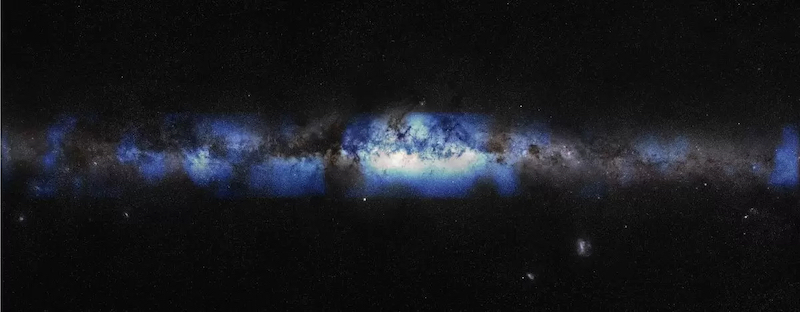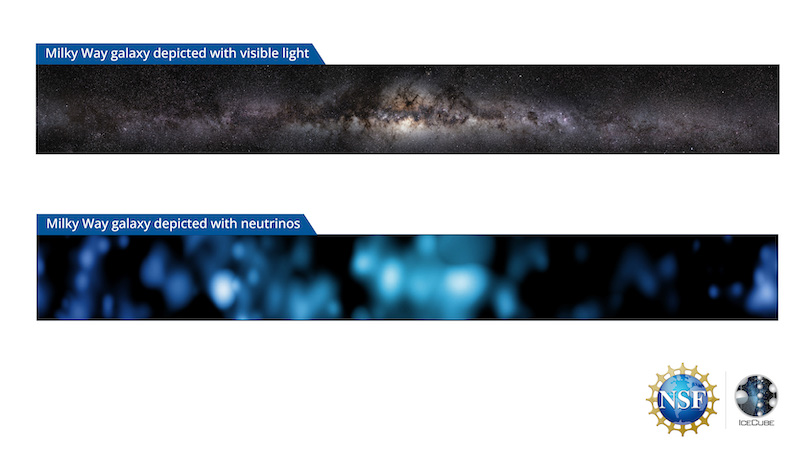
We’ve all seen photos of our Milky Way galaxy as a beautiful band of stars stretching across the night sky. In addition to views of the Milky Way in visible light, astronomers have shown us our home galaxy in other wavelengths of the spectrum, from radio waves to gamma rays. On June 29, 2023, a team of researchers using the IceCube Neutrino Observatory in Antarctica released a new image of the Milky Way … a view never seen until now. It’s the first image of our galaxy in something other than electromagnetic radiation. This image captures the galaxy with neutrinos, or ghost particles.
The National Science Foundation (NSF) supports IceCube, which is located at the Amundsen–Scott South Pole Station in Antarctica.
The researchers published the peer-reviewed results in Science on June 29, 2023.
Viewing the Milky Way with neutrinos
This is the first time anyone has imaged our galaxy using neutrinos, aka ghost particles. Physicist Naoko Kurahashi Neilson at Drexel University in Philadelphia stated:
I remember saying, ‘At this point in human history, we’re the first ones to see our galaxy in anything other than light.’
Neilson, Steve Sclafani at Drexel and Mirco Hünnefeld at TU Dortmund University in Germany were the first ones to study the new image.
The bright spots in the image are locations in the Milky Way where the neutrinos are emitted. As it happens, those locations are in places where gamma rays are thought to be the byproducts of collisions between cosmic rays and interstellar gas. Those collisions should theoretically produce neutrinos. Sclafani said:
A neutrino counterpart has now been measured, thus confirming what we know about our galaxy and cosmic ray sources.
Moreover, the bright spots also differ from visible light wavelengths. Francis Halzen, a physicist at the University of Wisconsin–Madison and principal investigator at IceCube, said:
What’s intriguing is that, unlike the case for light of any wavelength, in neutrinos, the universe outshines the nearby sources in our own galaxy.

Tracing the origins of neutrinos
The search for the neutrinos focused on the southern sky. From the southern sky it’s easier to see the galactic plane that’s near the center of our galaxy. This is the region where astronomers believe the bulk of neutrino emission comes from.
By nature, neutrinos are elusive to detect. And, with this in mind, researchers want to know where they come from. Neutrinos rarely interact with the ice beneath IceCube in Antarctica, but when they do, they produce faint patterns of light. Some of them point to specific areas of the sky. So, by following the path they took, astronomers can tell where they originated from. For example, in 2022, IceCube detected neutrinos that came from a galaxy 47 million light-years away.
Other patterns, however, are less clear. They are less directional and tend to produce what the astronomers call “fuzz balls of light.” Overall, IceCube has detected over 60,000 of these cascading “fuzz balls” in the past 10 years. That’s 30 times as many as in a previous analysis of the galactic plane using cascade events.
More specifically, these “cascade” events are neutrino interactions in the ice that result in roughly spherical showers of light.
Also, neutrinos may be tiny, but they pack an amount of energy millions to billions of times higher than those produced by the fusion reactions. It is those reactions that power stars.
Ignacio Taboada, a professor of physics at the Georgia Institute of Technology, said:
The strong evidence for the Milky Way as a source of high-energy neutrinos has survived rigorous tests by the collaboration. Now the next step is to identify specific sources within the galaxy.

Advances in technology
IceCube is extremely sensitive, and represents the latest in neutrino detection technology. It detects the subtle signals of high-energy neutrinos from space by using over 5,000 networked light sensors buried deep within 0.2 cubic miles (0.8 cubic km) of pristine ice. As Denise Caldwell, director of the Physics Division at The National Science Foundation noted:
As is so often the case, significant breakthroughs in science are enabled by advances in technology. The capabilities provided by the highly sensitive IceCube detector, coupled with new data analysis tools, have given us an entirely new view of our galaxy, one that had only been hinted at before. As these capabilities continue to be refined, we can look forward to watching this picture emerge with ever-increasing resolution, potentially revealing hidden features of our galaxy never before seen by humanity.
As Hünnefeld also noted:
The improved methods allowed us to retain over an order of magnitude more neutrino events with better angular reconstruction, resulting in an analysis that is three times more sensitive than the previous search.
And this is just the beginning. Neilson thinks that using neutrinos in astronomy will lead to even more discoveries. And that is the essence of science, she said:
This is why we do what we do. To see something nobody has ever seen, and to understand things we haven’t understood.
She added:
As neutrino astronomy evolves, we will get a new lens with which to observe the universe.
Bottom line: Scientists released a new “ghost particle” image of the Milky Way. It is the first-ever image taken of our home galaxy using neutrinos instead of visible light.
Source: Observation of high-energy neutrinos from the Galactic plane











